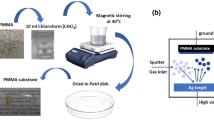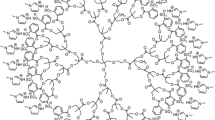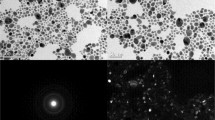Abstract
Nanostructured silver films of different thicknesses were deposited on surfaces of polypropylene nonwovens by magnetron sputter coating to obtain antibacterial and electrical conductive properties. The surface morphology of nanostructured silver films was investigated by atomic force microscopy (AFM). The antibacterial properties of the nonwovens coated with relatively thinner films were evaluated using the shake flask test. The conductivity of the nonwovens coated with relatively thicker films was examined using an ohm-meter. The results of the antibacterial test revealed that the antibacterial performance improved gradually as the film thickness increased from 0.5 to 3 nm. It is believed that the total amount of silver ions released from the coating was increased along with the increase in film thickness. As sputtering time prolonged, the grain sizes of the silver particles were increased and the coating became more compact. The results of the electrical conductivity test showed that the increased film thickness led to the improved electrical conductivity when the film was relatively thicker. The AFM images clearly revealed the change in surface morphology formed by sputter coating. The growth and coverage of the coating layer contributed to the improvement in its antibacterial and conductive properties.
Similar content being viewed by others
Explore related subjects
Discover the latest articles, news and stories from top researchers in related subjects.Avoid common mistakes on your manuscript.
Introduction
Metalized textile is a kind of new composite material that has attracted the attention of scientists and engineers due to its special properties such as heat radiation resistance, oil repellence, soil repellence, and antimicrobial and electrical conductivity.1 It is well known that silver has a broad antibacterial activity while exhibiting low toxicity towards mammalian cells.2 Thus, nanostructured silver film deposited on textile substrates can be used to make ideal functional textiles, which have great potential for applications ranging from fibrous solar cell, conductive shields, and electronic sensors, to antibacterial materials.3–6 Sol-gel and CVD techniques have often been used to prepare nanostructured silver films. Sol-gel provides a simple technologic approach to make functional materials, but the prepared films are not uniform and compact. In addition, the bonding force between film and substrate is too low to adapt to the durable applications. While in chemical plating process,7 chemical silver coatings are formed as a result of a chemical reaction between the reducing agent and metal ions presented in the solution, which has some disadvantages with regards to the environment.
Magnetron sputter coating, developed during the 1970s, is a vacuum process, which has been widely used to deposit very thin films on various substrates for commercial and scientific purposes. It is preformed by applying a high voltage across a low-pressure gas to create plasma, which consists of electrons and gas ions in a high-energy state. During sputtering, energized gas ions strike a target, composed of the desired coating material, and cause atoms from the target to be ejected with enough energy to travel to and bond with the substrate, forming a functional coating. Magnetron sputter coating technology has such advantages8 as being uniform and compact, having stronger bonding between the film and its substrate, and it is environmentally friendly. Currently, various forms of metals, glasses, and chinaware have been chosen as substrates for various applications,9 while textiles used as substrates were rarely reported.
In this study, nanostructured silver films of different thicknesses were deposited on the surfaces of polypropylene (PP) nonwovens by magnetron sputter coating. AFM was employed to analyze the effects of sputtering conditions on surface morphology of nanostructured silver films. Shake flask test was used to investigate the antibacterial properties of samples with relatively thinner films. Ohm-meter was used to examine the conductivity of samples with relatively thicker films.
Experimental
Materials pretreatment
Spun-bonded PP nonwovens with an area mass of 100 g/m2 were used. The samples were first immersed in acetone solution for 30 min to remove the organic solvent and dust on the materials, and then were washed twice with deionized water. The samples were dried at a temperature of 40–45 °C after washing. The dried samples were cut into 2.3 cm by 7.3 cm pieces for sputtering.
Sputtering
A magnetron sputter coating system supplied by Shenyang Juzhi Co., Ltd. was used to deposit the nanostructured silver film onto the surface of PP nonwovens at room temperature. A high purity silver target (diameter: 50 mm; purity: 99.99%) was placed below the substrate at a distance of 170 mm and the sputtered silver particles were deposited onto the nonwoven substrates. To avoid the deformation of substrate and the diffusion movement of silver particles caused by high temperature, water-cooling equipment was used to bring down the temperature of the substrate during the sputtering. The sputter chamber was first evacuated to a base pressure of 5 × 10−4 Pa prior to introducing the high purity argon gas as bombardment gas. During the sputtering, the substrate holder was rotated at a speed of 100 rpm to ensure that the silver particles uniformly attached on the substrate. In this study, two groups of samples were prepared to obtain the different functions. In each group, gas flow, sputtering power, and sputtering pressure were kept constant, and the sputtering time was adjusted to change the thickness of deposition. The sputtering conditions are detailed in Table 1. Thicknesses of the films were measured using a film thickness monitor (FTM-V) that was fixed in the chamber.
Surface characterization
A CSPM4000 AFM made by Benyuan Co, Ltd. was employed to scan the surface morphology of all samples in contact mode. The scanning size was 5000 x 5000 nm, and the scanning frequency was set at 1.0 Hz. The effect of sputtering conditions on the surface morphology was analyzed based on the AFM observations.
Antibacterial test
Shake flask test was used to assess antibacterial properties of samples in Group 1 (sample 1 to sample 4) according to GB15979-2002 [health standard for disposable hygienic articles].10 Escherichia coli, ATCC 25922, a gram-negative bacterium, was used as the test bacteria. In addition to the coated samples, an uncoated PP substrate was also tested for comparison. The bacteria were incubated at 37 ± 1 °C for 36 h before counting.
The antibacterial properties of the substrates coated with the silver film were evaluated by calculating the reduction percentage of bacteria by the following formula:
where Xs is the reduction percentage of bacteria; A is the number of bacteria colonies on the agar plate recovered from bacterial solution at 0 contact time; and B is the number of bacteria colonies on the agar plate recovered from the specimen after shaking for 1 h. If the number of bacteria after shaking is larger than the number at 0 contact time, Xs = 0.
Electrical conductivity
Electrical conductivity of samples in Group 2 (sample 5 to sample 7) were measured using an ohm-meter. Resistances at 1, 2, and 3 cm longitudinal intervals of every sample were tested. In order to minimize the deviations brought on by the unevenness of the textile surface, resistances at different intervals of each sample were tested five times, and the average values were used.
Results and discussion
Surface morphology
The AFM images of the uncoated PP surface are presented in Fig. 1a. The AFM images of PP surfaces coated with nanostructured silver films of different thicknesses ranging from 0.5 to 3 nm are given in Fig. 1b–e.
The AFM image in Fig. 1a shows that the uncoated PP fiber had a smooth surface without any particles but with clear periodic stripes on its surface. The periodic stripes were probably induced by drawing during the post-processing of the PP fiber, leading to the orientation of the molecular chains along the fiber axis.11 It can be seen from Fig. 1b that there were some nanosized silver particles scattered on the PP surface, and the stripes were still visible when the film thickness was about 0.5 nm. When the film thickness was increased to 1 nm, the surface of the fiber was fully covered with silver nanoclusters, as displayed in Fig. 1c, so the stripes were not visible anymore. The image also revealed that the silver particles had relatively homogeneous grain sizes, despite a few aggregations. The image in Fig. 1d indicates that the variation in grain sizes of silver particles got larger, but the interspaces between particles were decreased when the film thickness was increased to 2 nm. Some aggregates with large grain size could also be seen on the fiber surface. When the film thickness reached 3 nm, grain sizes were obviously increased because of the growth of the nanoparticles, as shown in Fig. 1e.
The AFM images in Fig. 1 reveal that when the film was relatively thinner, the nanosized silver film was formed by homogeneous particles, assuming continuous coverage. Sputtering time affected the grain sizes of silver particles. As sputtering time prolonged, grain sizes of silver particles were increased and the film became more compact. It is conceivable that nanostructured silver particles on the PP surface became denser and denser as sputtering time prolonged. When the interspaces between silver particles were small enough, the sputtered particles collided with the particles on the PP surface, forming particles with larger grain sizes.
The AFM images of the fiber coated with the silver films of different thicknesses ranging from 50 to 200 nm are presented in Fig. 2a–c.
The clusters with larger grain sizes were formed on the surface of the fiber coated with a layer of 50 nm, as illustrated in Fig. 2a. The variation in grain sizes of the silver particles became larger, thus the surface of the fiber got rougher, compared to those of thinner films. The variation in grain sizes of the silver particles, however, decreased when the film thickness reached 100 nm, as exhibited in Fig. 2b. It can be clearly seen that silver particles were quite uniformly distributed on the fiber surface, thus the smoothness of the film was improved and the film got more compact. When the film thickness was increased to 200 nm, the silver particles became more even, and the film had a better smoothness and excellent compactness, as shown in Fig. 2c.
The AFM images in Fig. 2 indicate that the increased film thickness led to the improved surface smoothness and the compacter structure of the film, when the film was relatively thicker from 50 to 200 nm. It is believed that the growth of the silver particles was not even, resulting in large variation in grain sizes of the particles and rough film surface when the film thickness was 50 nm. As the sputtering time increased, the growth of the silver particles became even and the variation in grain sizes of the silver particles was reduced, improving the smoothness of the sputtered film.
Antibacterial properties
The recovered bacteria counts of samples in Group 1 (sample 1 to sample 4) under serial dilutions are reported in Table 2. Results in Table 2 demonstrate that all the coated PP nonwovens, except uncoated nonwovens, were effective against E. coli. When the thickness of the sputtered silver film exceeded 1 nm, the percent reduction of bacteria was over 86%. The increased film thickness resulted in the gradual increase in antibacterial properties. This is because the performance of silver as an antibacterial coating is dependant on the activity of the silver ions and the total amount of silver ions released from the coating. Increasing the coating thickness obviously led to the release of a larger amount of silver ions, which contributed to the antibacterial performance. Silver is very expensive and silver coating thickness over 25 nm may be toxic to certain human cells;12 therefore, the optimal coating thickness is about 2 nm to assure the excellent bacterial properties and to save cost.
By comprehensive analysis of AFM images and bacterial test results, it can be concluded that the antibacterial properties of the materials were improved as the sputtering time increased, resulting in the improved compactness of the films and the increased release rate of silver ions.
Electrical conductivity
The results of the electrical conductivity test for the samples in Group 2 (sample 5 to sample 7) are given in Table 3.
Results in Table 3 clearly show that the resistance of the materials was decreased as the film thickness increased. The thinner film had looser structure, which could form electric potential barriers, resulting in the higher resistance. Moreover, when the film was rougher and had a larger variation in grain sizes, the connections among the silver particles were affected, causing the decrease in electrical conductivity.
Conclusions
The sputter coating formed nanosized particles that scattered on or covered the fiber surface subject to the sputtering times when the sputtered film had a thickness less than 3 nm. Sputtering time affected the grain sizes of the silver particles formed on the fiber surface. As the sputtering time increased, the grain sizes of the silver particles increased and the film became more compact. The antibacterial properties of the substrate were improved as the sputtering time was increased because the surface area of silver film was also increased and the rate of release of silver ions was also increased.
When the film had a thickness over 50 nm, the increase in sputtering time led to the improved surface smoothness and the more compact film structure, resulting in the improved electrical conductivity.
References
Zhou, JX, Zhao, F, “Development and Application of Metalized Textile Materials.” Shanghai Textile Sci. Technol., 29 47–48 (2001)
Scholz, J, Nocke, G, Hollstein, F, Weissbach A, “Investigations on Fabrics Coated with Precious Metals Using the Magnetron Sputter Technique with Regard to Their Anti-Microbial Properties.” Surf. Coat. Technol., 192 252–256 (2005)
Banchi, L, “New Trends in Technical Textiles.” Rivista Della Technologie, 3 62–69 (2001)
Catrysse, M, Puers, R, Hertleer, C, Van Langenhove, L, van Egmond, H, Matthys, D, “Towards the Integration of Textile Sensors in a Wireless Monitoring Suit.” Sensors Actuators A, 114 302–311 (2004)
Gould, P, “Textiles Gain Intelligence.” Materials Today, 10 38–43 (2003)
Sant, SB, Gill, KS, Burrell, RE, “Morphology of Novel Antimicrobial Silver Films Deposited by Magnetron Sputtering.” Scripta Materialia, 12 1333–1339 (1999)
Jiang, SQ, Newton, E, Yuen, CWM, Kan, CW, “Chemical Silver Plating and Its Application to Textile.” J. Appl. Polym. Sci., 96 919–926 (2005)
Sun, DM, “The Characteristic and Design Principle of the Target which has a Cylinder Shape and Working Method Identical with Plane Target.” J. Kunming University Sci. Technol., 25 54–57 (2000)
Zhao, XQ, “The Application of Sputter Coating.” Electron. Mech. Project, 79 58–61 (1999)
GB15979–2002 [Health Standard For Disposable Hygienic Articles]
Wei, QF, “Surface Characterization of Plasma-Treated Polypropylene Fibers.” Mater. Charac., 52 231–235 (2004)
Dowling, DP, Donnelly, K, McConnell, ML, Eloy, R, “Deposition of Anti-Bacterial Silver Coatings on Polymeric Substrates.” Thin Solid Films, 398–399 602–606 (2001)
Acknowledgments
The research was supported by the Key Project of Chinese Ministry of Education (No. 106089) and Southern Yangtze University (No. 2005LYY014).
Author information
Authors and Affiliations
Corresponding author
Rights and permissions
About this article
Cite this article
Wang, H., Wang, J., Hong, J. et al. Preparation and characterization of silver nanocomposite textile. J Coat Technol Res 4, 101–106 (2007). https://doi.org/10.1007/s11998-007-9001-8
Published:
Issue Date:
DOI: https://doi.org/10.1007/s11998-007-9001-8






